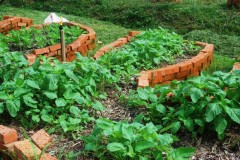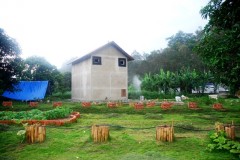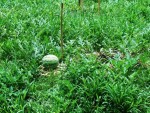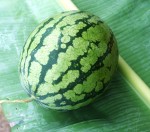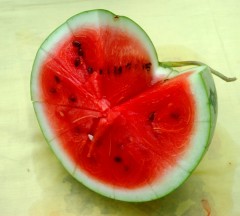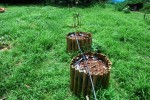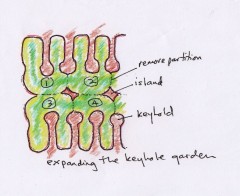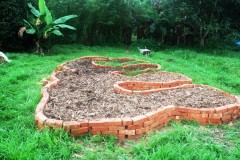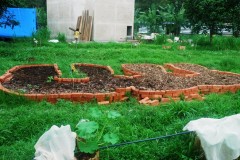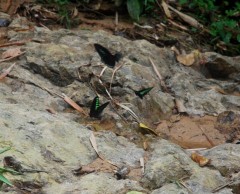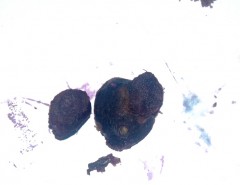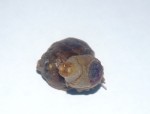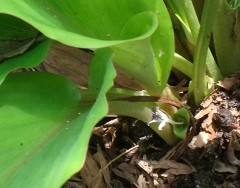Oct 28, 2009
Expanding Keyhole Raised Beds - Harvest Time
The Bayam Pasir (wild amaranth), a personal favourite is ready for harvest. And to be frank, I did not even visit the bed once since we sowed the seeds three weeks ago. Nobody did any weeding, the farm hand just turn on the sprinkler occasionally when the compost was dry to the 'poked-finger' and once a week sprayed some compost tea.
Note: Bayam Pasir draws unhealthy levels of nitrates from chemical NPK fertilisers. Always use low N compost. Avoid eating too much 'modern' hybrid vegetables grown conventionally. Always chose vegetables grown on compost such as Grace Cup, even though they may not be certified. Choose organic vegetables that are non-'modern' hybrid (heritage or heirloom) and slow growing, and grown on compost too. Talk to your farmer.
Avoid buying from 'organic' corporate farmers. They will use high NPK 'organic' fertilisers, high N demanding vegetable varieties (faster growing and larger), etc. Too much of these vegetables may cause imbalances in our bodies.
19:15 Posted in Permaculture | Permalink | Comments (0) | Tags: : keyhole beds, raised beds, organic vegetables, no-dig garden, permaculture
Caviar of the East - Calling The Walit
Today we had our first trial run calling the walit.
Completed walit house.
We switched on the 'bazooka' tweeter for the first time. It's that dark outline jutting up on the roof, in the picture. It has a range of 1 km.
And the walit came after just 5 minutes ! We counted easily a hundred! They dove down and around the house and some went in on investigatory flights.
Now we wait for some newly wed couples to make our house their home.
18:36 Posted in Blog | Permalink | Comments (2) | Tags: walit, swiftlets, aerodramus fuciphagus, aerodramus maximus
The Ministry Came to Audit Today
Officers from the Ministry of Agriculture came today to audit the farm on its organic compliance. Water and plant samples were taken and records were carefully checked. The auditors even asked after the welfare of the workers.
Puan Nurul Al Hana and Tengku Azman, auditors from the Ministry having a cup of mulberry leaf tea after the audit.
18:21 Posted in Blog | Permalink | Comments (0) | Tags: organic certification, som, auditors
Oct 27, 2009
Poultry Litter Fed To Cows?
I am worried about this emphasis on bio-technology in recent years in our country.
It is as if the centuries of farming experience by our fore-fathers should all be discarded. Our fore-fathers look at farming as producing nutrition for human consumption. Not maximising production.
I am sure, it is the fresh-faced, soft-spoken 'food' scientists who came up with 'smart' solutions like feeding cows and sheep with cow organs and discards and ended with mad-cow disease. Would our fore-fathers ever dream of doing such a thing?
And also it must be 'food' scientists who came up with hydrogenated vegetable oils to replace animal fats and ended up giving a few generations here spoonfuls of trans-fats every day (we use margarine for bread, for chicken rice, for cookies, cakes, etc.).
It may come as a surprise but many of these food scientists are not trained in human nutrition.
The first person who told me about omega 6 and its inflammatory effect at the cellular level was a veterinary science graduate. He spoke about it from the perspective of poultry health and that since broilers have such short lives, cancers etc will not show up.
But surprisingly, he did not make the connection between poultry health and humans who eat the chicken! He did not see the link between chickens with high levels of omega 6 and humans who eat those chickens year after year.
Scientists are like corporate guys – they have very narrow objectives. They must show results. The 'smart' ones coming out with 'smart' solutions will see career advancements and bonuses.
So, they sit and think and think and come up with feeding chicken litter to cows, and with 'scientific' results to prove it is 'scientifically proven'. The corporate types will most probably use the study to justify implementing such a scheme.
Or to push down plastic brushes into the throats of cow to improve digestion (the cows with plastic scrubbers gain 16% more. The corporate farmers will be jumping for joy here!)
Or to feed the cows stale chewing gum in their plastic wrappers (can reduce corn-alfafa meal by 30%) .
Bio-technology is fine. Science is fine. But you must have a guy with loads of common-sense who is keenly aware of possible long-term side effects to make the final decisions. Not the scientists.
For example, will the use of plastic scrubbers cause the cow to produce certain hormones or enzymes which may affect human health if consumed over extended periods of time? All angles from the human long term perspective should be addressed before allowing these 'smart' solutions to be implemented.
Better yet, spend that money on R&D to improve pasture management. For example at our farm, we can produce enough grass for 200 goats from one acre of land. The current standard is 15 goats per acre here. Just not enough money is going into improving basic traditional farming. It is just not glamorous and unfortunately does not have the immediate impact on GDP like a few hundred million poured into some 'modern' farming centre.
What Can You Do?
1. Buy from small farmers. Buy local.
2. Reduce or avoid processed foods.
3. Know your farmer (especially corporate farmers). He cannot farm in secret. He must allow visitors, if not yourself then other consumers like you.
4. Know the farming methods used by your farmer.
12:57 Posted in Corporate Farming | Permalink | Comments (0) | Tags: corporate farming, litter fed to cows
Oct 26, 2009
Recycled Cooking Oil - Fed To Chickens?
I worked in a multinational before. I know the pressures. I know the incessant need to look for 'growth' and profits. Which is why I think corporations should not be allowed to do farming. The culture and the ethics are worlds apart!
The temptation to listen to 'smart' guys in the board room when you are under pressure is tremendous. I think that brought down Wall Street last year.
If you are a corporation and under pressure to reduce feed costs, and if a 'smart' guy suggests 'recycled' cooking oil from either a supplier or better yet, from your own chain of restaurants, would you even lose a night's sleep before giving the go-ahead? If it means 30%, 50% savings?
Don't believe me? Don't believe that they feed chickens with recycled cooking oil? Then read this:
http://www.dqcleanchicken.com/RecycledOilForSaleFeed.doc
The use of recycled cooking oil for animal feed is a 'smart' idea. It saves disposal costs, reduces pollution and the animals don't know better. It is an idea that is surely born out of a corporate board room. And the guy who came up with the idea most probably received a medal.
The BBC called me a few months back asking about animal husbandry practices in Malaysia. I mentioned about the use of vegetable oils to fatten animals. I am sure the interviewer yawned. And he replied that they do the same in the U.K. With the addition of fats, the chicken will reach the desired weight maybe two weeks earlier (you don't need hormones, enzymes, etc. as fats work better). The Authorities are happy that food production is going up. The food scientists have done their job. The corporate farmers are happy as cash-flow have improved.
But nobody from the industry looked at the effects from eating meat produced in such a manner. Who's responsibility is that? There's only so much education one man can do (I raised the issues in my talks since 2001).
The high fat intake will cause the body of the animal to manufacture more of its own saturated fats thereby increasing its ratio in the meat. Chickens fed fats can have a saturated fat content that's as high as red meats - 8 to 10%. The higher the saturated fats, the higher the cholesterol content. Chickens fed fats can have cholesterol content that's as high as, or even higher than beef. One chicken I tested had 72mg/100grams. That's the level of beef and lamb!
And since we eat more chicken meat more often than red meat, without realising it we have piled on the saturated fats into our diet. Especially we Asians who love the 'drum stick'. The total lipids of the darker meats can be as high as 30%, excluding bones. And don't forget the omega 6: omega 3 ratio. With the fats and the grains, that's screwed up too. One factory chicken I had tested recorded a ratio of 59:1. That is a nutritional disaster! The recommended ratio is 4:1 or less.
What can you do?
1. Support small farmers, in particular local farmers.
2. Reduce purchase of food produced by faceless corporations, in particular meat products.
3. Ask yourself this question: why am I trusting the production of food for my family to a faceless corporation? Don't just trust a brand-name. Take back some of the responsibility of providing food for your family by finding out more about the food producer, check out the labelling, read, check the internet, ask people. Plant your own, grow your own; even if it is to meet just a small part of your requirements.
16:45 Posted in Corporate Farming | Permalink | Comments (0) | Tags: corporate farming, recycled cooking oil, energy for chickens
Sep 30, 2009
Organic Watermelons Anyone?
I love watermelons and just cannot find organic ones.
So we decided to grow our own.
Watermelons need sandy soil and plenty of water.
Watermelons on the way.
Almost ready for harvest. So far, no loss to insects and disease due to our sprays of Teh Qi and herbs.
Our first watermelon
Beautiful color and juicy; shared by Alternative Mom and her family with us.
Next, watermelon on raised beds:
If successful, we will go commercial as the market have very little and inconsistent supply of organic watermelons.
18:12 Posted in Blog | Permalink | Comments (0) | Tags: watermelons, raised beds, organic watermelon
Sep 24, 2009
Expanding Keyhole Raised Beds
One of the biggest headaches in organic vegetable farming in Malaysia is weeds. The weeds just grow too fast; napia, as an extreme example can reach 5 feet in 30 days. And do not forget lalang! Some conventional farmers here lay the entire planting area with plastic sheeting. Heck, some commercial organic farms do the same!
Weeding is back-breaking work especially for those new retirees who dream of establishing an organic farm: your back is going to give up before your first harvest.
Raised bed is one answer. For the new farmer, you can use an expandable raised bed design that we have developed to suit our local conditions and needs:
1. To increase your production capacity as your sales increases.
2. To reduce labour costs
3. To reduce weeding costs
4. To reduce dependence on machinery
5. To ensure long term soil fertility
6. To eliminate digging and tilling of the soil
Soil fertility has not been a problem with us using raised beds. Earthworm population remains high. And replanting by crop rotation and continuous adding of compost into the raised beds keeps production at optimum levels harvest after harvest.
This is the expandable raised bed design developed by us based on designs developed by permaculturists. The keyhole and curved edging allows for maximum utilisation of space, and it looks good compared to straight rows of beds.
(Click for close-up):
Bed One
Close up of bed One. You can reach half of the bed from within the keyhole and the other half from the outside edge of the raised bed.
How about that? After one month, still no weeds (well, if you can call those few pathetic sprouts, weeds). Notice how the top layer has changed to a darker color over the month. This is indicative of earthworm activity.
Adding Bed Two after one month
It is preferable to use stones or discarded bricks and concrete blocks to make your raised bed walls ( I make it a habit nowadays to stop at demolition and construction sites to pick up old bricks, etc). It is a one-time investment in labour and costs, and lasts forever as opposed to bamboo, timber, etc. Remember that in Malaysia, labour costs are a large component of your production cost and you do not want to incur labour costs repeatedly for the same thing.
(Click for close-up)
Another view: Beds One and Two, expanding laterally.
Now that we have demonstrated that even after 30 days there is no weed problems, we have started sowing Bed One with 3 different varieties of vegetables and in Bed Two, a wild amaranth (bayam pasir), a personal favourite. Go for heritage seeds when you first start out. They will do very well on compost and raised beds, have less disease and insect problems and will be very forgiving of your mistakes.
20:28 Posted in Permaculture | Permalink | Comments (2) | Tags: keyhole beds, raised beds, organic vegetables, no-dig garden, permaculture
Sep 14, 2009
Amongst the Raja Brooke's Birdwings
Did two hours of taichi and qi gong at this small cascading stream near the farm yesterday. The place was deserted.
Click on pictures to enlarge
A group of about ten Raja Brooke's Birdwings came to join me, fluttering around me with no fear.
And a pair of pretty yellow-green butterflies.
It doesn't get much better than this.
This morning my BP was 115 / 68; like new. And that crick in the knee was gone.
Have to make it a habit to do the exercises here, each week; amongst the Raja Brooke's Birdwings
20:51 Posted in Blog | Permalink | Comments (0) | Tags: raja brooke's, birdwing butterflies, qi gong, tai chi
Sep 09, 2009
Black Curcuma / Black Turmeric
We have this very delicate small curcuma (barely a foot tall) that produces a completely black rhizome.
It is clearly not temu hitam or curcuma aeruginosa roxb. The temu hitam plant is larger, more robust and the rhizome is only slightly bluish. The leaves of the temu hitam have a purplish spine and the flower is reddish, pinkish.
Click for close up
The completely black / deep purple rhizome.
Click for close up
The rhizome before removing the thin skin.
It does not seem to be curcuma caesia or Kali Haldi (click on word for wiki article) which looks like curcuma aeruginosa.
Click for close-up
Anybody knows the scientific name for this curcuma? I have not been able to find any reference to it.
NOTE 22/7/2012 : TWO READERS OF THIS BLOG, ONE FROM HAWAII, AND ANOTHER FROM LANGKAWI, PAK DIN, http://herbwalk-langkawi.com.my/thewalk.html HAVE IDENTIFIED THIS PLANT AS Kaempferia parviflora, A PLANT FOUND IN NORTHERN THAILAND AND USED EXTENSIVELY FOR TRADITIONAL MEDICINE. THANKS TO BOTH FOR HELPING OUT.
THE PLANT WAS FOUND IN A FOREST NEXT TO OUR FARM. WE TAKE NOTE THAT THE FOREST IN QUESTION IS BOUNDED ON THREE SIDES BY FARMS AND ON ONE SIDE BY A FOREST RESERVE. WE CAN ONLY SPECULATE HOW IT WAS INTRODUCED INTO THE FOREST, THOUGH WE MUST ADMIT IT SEEMS EXTREMELY WELL ADAPTED TO THE CONDITIONS LOCALLY AND WE HAVE NEVER SEEN ANY DISEASE AFFECTING THE SAID PLANT.
15:18 Posted in Blog | Permalink | Comments (8) | Tags: black turmeric, kunyit hitam, temu hitam, kali haldi, curcuma aeruginosa, curcuma caesia
Aug 29, 2009
The Tree
Tok Guru on tree planting and the act of Ibadah:
00:36 Posted in Blog | Permalink | Comments (0) | Tags: tok guru, ibadah








